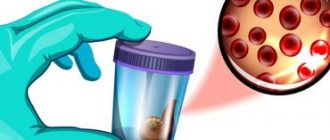There is probably no person in the world who has never experienced external bleeding in their life - for example, from careless handling of a knife when cutting food or from an unfortunate fall from a bicycle that ends in broken knees. The rules of first aid in such situations are simple and well known to everyone. You need to disinfect the wound and stop the bleeding with a bandage or plaster. And if a large vessel (artery) is hit and blood spurts out, then it is necessary to clamp the vessel above the wound site to avoid large blood loss.
Obviously, any bleeding occurs due to the fact that the integrity of the blood vessels is disrupted. Blood stops circulating in the closed space of the vessels and flows out of them. If the integrity of the uterine vessels is compromised, blood flows out through the vagina. It is this external sign that is the reason to suspect something is “off” and consult a doctor.
Uterine bleeding is a symptom of many diseases. These may be gynecological or oncological diseases, as well as complications of pregnancy and childbirth.
In case of uterine bleeding, it is very important not so much to stop the blood loss - this, by the way, is not always the first priority measure - but to identify the cause of the bleeding and, if possible, eliminate it. If this is not done, then there is a high probability of relapse and other manifestations of the disease, as well as its complications. Manipulations aimed at stopping bleeding are carried out in cases where the process of blood loss occurs at a high rate - in this case there is a direct threat to life. After the bleeding has been eliminated, in addition to treatment, restorative procedures must be prescribed: regimen, nutrition, maintaining water balance in the body, vitamin therapy.
Dysfunctional uterine bleeding
Dysfunctional uterine bleeding is bleeding associated with dysfunction of organs, in the absence of any organic pathology (uterine fibroids, internal endometriosis, pathology of the cervix, tumors of the uterus and ovaries).
Ovarian dysfunction is caused by a violation of their hormonal function and occurs quite often. Many women take this disease lightly and do not see it as a direct threat to health. In addition, there is a very common opinion that dysfunction is just a minor malfunction of the body, with which you can live safely, but it is useless to treat it. This approach is fundamentally wrong. Firstly, ovarian dysfunction may be a manifestation of some deep hormonal imbalances that require certain correction. Not to mention that it is unlikely that you will be able to “live well,” because dysfunction is almost always accompanied by physical and moral discomfort and pain. A woman is forced to constantly use analgesics, the body gradually gets used to them, the pain intensifies again... It turns out to be a vicious circle.
The main symptom of dysfunctional bleeding is irregular menstrual cycle. The reason to consult a doctor is when the interval between menstruation is less than 21 days and more than 35 days. It is also not considered normal if:
- menstruation lasts more than 7 days;
- menstrual bleeding is very heavy, a woman is forced to change pads or tampons every hour, including at night;
- Menstruation is accompanied by severe nagging pain in the lower abdomen.
If such symptoms recur over three or more menstrual cycles, then you need to visit a doctor as soon as possible.
Endocrine causes are not always the cause of dysfunction. The functioning of the ovaries can also be affected by factors such as:
- overweight or underweight;
- diabetes;
- frequent stress and depression;
- infectious diseases (flu, pneumonia, sore throat);
- strict diet and fasting;
- genital infection;
- sudden climate change.
Therefore, when going to see a doctor, be prepared that he will ask you questions about your diet, nervous stress, previous diseases and changes in the climatic environment.
Diagnosis of ovarian dysfunction includes a gynecological examination, smear analysis, blood test for hormones, ultrasound of the thyroid gland, adrenal glands and pelvic organs. The doctor may also prescribe magnetic resonance imaging of the brain and separate diagnostic curettage of the uterus.
Treatment is selected individually in each case. First of all, it is aimed at normalizing hormonal levels and correcting lifestyle. In any case, the doctor tries to choose the most gentle therapy. In cases where adolescents or premenopausal women suffer from dysfunction, it is often enough to reduce the level of tension, review the diet and allocate time for active rest and good sleep. The body reacts sensitively to changes that are favorable to it and successfully self-regulates without drug treatment.
What symptoms may occur?
You need to visit a gynecologist if you have the following symptoms:
- You have noticed that your periods have become heavier than before. A woman may notice that she begins to spend more hygiene products and has to choose more “drops”.
- During your period, you begin to feel worse, and pain occurs. Worried about weakness, increased fatigue.
- The duration of menstruation has increased.
- There is pressure, discomfort, pain in the pelvis.
- Enlargement of the abdomen, something dense can be felt in it. If the fibroid is large enough, it protrudes and is noticeable when the woman lies on her back.
- I am worried about pain in the pelvis and legs.
- Urination has become frequent or difficulty occurs during urination.
- Constipation occurs constantly.
- Your vagina leaks blood when you don't have your period.
These signs may indicate not only fibroids; they occur in various diseases. An accurate diagnosis will be made by a gynecologist after examination and ultrasound.
Bleeding due to uterine fibroids, adenomyosis, endometrial and cervical canal polyps
Uterine fibroids, endometriosis and polyps and endometrial hyperplasia are diseases associated with benign growth of uterine tissue. They appear most often during reproductive age.
All this pathology is easily diagnosed using ultrasound. As a rule, no additional examination methods are required. You can read about possible treatment options for uterine fibroids in the corresponding section of the website www. ya-zdorova.ru. In the presence of pathology of the uterine cavity, hysteroscopy with the appropriate amount of surgical intervention is indicated to eliminate the cause of bleeding.
Causes
Women with a hereditary factor, excess weight, early menstruation, physical inactivity, inflammation of the genital organs, nulliparous women exposed to constant stress are predisposed to the occurrence of uterine fibroids. The risks are increased in women who have been treated with antihypertensive drugs for 5 years in a row, with a history of frequent curettage of the uterine cavity. In premenopause and menopause, when ovarian activity and estrogen production are suppressed, the likelihood of developing a tumor is significantly reduced, but it exists in almost all women of any age, with any general and reproductive health condition.
The mechanism of development of fibroids: damage occurs in one cell of the myometrium, from which the growth of a subserous, submucosal, intramural, interligamentous or cervical node begins, depending on which part of the organ the defect occurred. Only one tumor-like formation can grow from each damaged cell. If several cells of the muscle layer are damaged, then a multiple form of fibroids will appear, and some of the nodes die on their own, while others develop.
According to one version, cells are damaged during embryogenesis, which explains the development of fibroids in girls at an early age. According to another version, a defect in myomatous cells occurs under the influence of various factors (abortion, inflammation, injury to uterine tissue).
Bleeding in cancer
One of the first manifestations of uterine and cervical cancer is uterine bleeding, although, as a rule, the process may not be at such early stages. It may not cause the woman any painful sensations, be scanty and short-lived. If such bleeding occurs during a regular menstrual cycle, you should immediately consult a doctor.
A timely visit to a gynecologist allows you to detect a tumor at an early stage and significantly increases the chances of a successful cure. The diagnosis can be made based on a gynecological examination, ultrasound and a number of tests.
Diagnostics
Often, fibroids are discovered accidentally during a medical examination or after heavy bleeding. The diagnosis is made based on diagnostic data:
| Type of diagnosis | results |
| History taking | The patient should be prepared for the doctor to ask not only general questions, but also questions related to the intimate sphere. The truthfulness of the answers affects the final result when making a diagnosis. |
| Gynecological examination | During a bimanual examination, the doctor determines the size and shape of the uterus, the intensity of pain, and the presence of bleeding. |
| Ultrasound sonography transvaginal or transabdominal | The main method of examination for fibroids. On an ultrasound image, the tumor is visualized as dense, round-shaped foci; the location, number, and size of the foci are determined. |
| Smear for microflora and STDs | Identification of pathogenic pathogens with possible inflammation. |
| Oncocytological smear | Detection of dysplastic processes in the uterus and appendages. |
| Hormonal panel | The level of estrogen and pituitary hormones is determined. |
| Blood and urine tests | Exclusion of the inflammatory process in the genitourinary system, determination of complications of bleeding (anemia). |
| MRI | To clarify the diagnosis. |
| Biopsy | For differential diagnosis and exclusion of a malignant process. |
For each patient, a set of studies is selected individually; all of the above methods are not necessarily used.
Obstetric hemorrhage
This term refers to intense bleeding that occurs immediately after childbirth. Their cause is a violation of the contractility of the uterus (atony or hypotension of the uterus), or a pathology associated with the blood coagulation system. Hypotony is a decrease in the tone of the uterus, which leads to its inability to actively contract. Atony is a complete loss of the ability to contract and respond adequately to medications and other types of stimulation. Obstetric hemorrhage is very dangerous because it leads to a large loss of blood in a short time. Very often the question is literally about saving a woman’s life - and then doctors decide on a hysterectomy, that is, removal of the uterus.
Blood coagulation mechanism and drugs
To understand which drugs will best help with uterine bleeding, you can briefly look at the normal mechanism of blood clotting. First, the damaged vessel must contract, which will reduce its lumen. Platelets in the river cling to each other and stick together, attach to damaged tissues, and form a plug.
When blood vessels, tissues, platelets and red blood cells are destroyed, the enzyme thromboplastin is released. It participates in a cascade of reactions together with other blood clotting factors and calcium ions, which leads to the synthesis of the active enzyme thrombin. Thanks to it and with the participation of the same calcium ions, insoluble fibrin protein filaments are formed from fibrinogen, which block the blood flow with a network of red blood cells entering it.
Vitamin K helps the liver synthesize a thrombin precursor called prothrombin and other clotting factors.
Medicines to stop bleeding can act on the coagulation system, thereby speeding up the chemical reactions necessary for the formation of a blood clot.
Some of them become a source of calcium and vitamin K. Another way is to reduce the activity of the fibrinolytic system, which in a healthy body destroys fibrin and does not allow the blood clot to grow uncontrollably. Another way to stop bleeding is to contract the blood vessels. This is how Oxytocin works.
| A drug | Active substance | Manufacturer | Price |
| Dicynone tablets 250 mg | Etamzilat | LEK dd (Slovenia) | 409 rub. |
| Dicynone solution for intramuscular and intravenous administration, 125 mg/ml | Etamzilat | LEK dd (Slovenia) | 569 rub. |
| Tranexam film-coated tablets, 250 mg | Tranexamic acid | NIZHFARM JSC (Russia) | 376 rub. |
| Tranexam solution for intravenous administration 50 mg/ml | Tranexamic acid | NIZHFARM JSC (Russia) | 1000 rub. |
| Vikasol tablets 15 mg | Menadion | USOLYE-SIBIRSKY CHEMPHARMZAVOD JSC (Russia) | 20 rub. |
| Calcium chloride solution for intravenous administration 100 mg/ml | Calcium chloride | JSC DALHIMFARM (Russia) | 66 rub. |
| Ascorutin tablets 50 mg + 50 mg | Ascorbic acid Rutoside | PHARMSTANDARD-UFA VITAMIN PLANT JSC (Russia) | 60 rub. |
| Aminocaproic acid solution for infusion 50 mg/ml | Aminocaproic acid | PROMOMED RUS LLC (Russia) | 60 rub. |
| Contrical lyophilisate for the preparation of solution for intravenous administration 10,000 ATRE | Aprotinin | Teva Pharmaceutical Industries Ltd. (Israel) | 500 rub. |
| Oxytocin solution for injection and topical use 5 IU/1 ml | Oxytocin | SYNTHEZ JSC (Russia) | 34 rub. |
| Pepper water extract liquid | Water pepper herb | ROSTOV PHARMAFABRIKA CJSC (Russia) | 47 rub. |
| FigoHemoStatic suppositories | Nettle extract Burnet extract Galangal extract Water pepper extract Shepherd's purse extract | Materia Bio Profi Center LLC (Russia) | 330 rub. |
Drugs to stop bleeding can be divided into first aid drugs and drugs whose effect develops slowly and serves to prevent bleeding. To accelerate the formation of blood clots on damaged vessels, an injection of Calcium chloride to supply the body with calcium ions or Oxytocin to increase the tone of the uterus and constrict blood vessels may be suitable. Dicynone and Tranexam act quickly and are available in tablets and solutions. The hospital may also use Contrical or Aminocaproic acid. Vitamin preparations and products based on plant extracts have a slow or preventive effect.
Quick stop of bleeding with Dicinon
A strong hemostatic agent called Dicynon, when injected into a vein, begins to act within 5-15 minutes and works for up to 6 hours. Its active substance is ethamsylate. The drug stops bleeding by influencing the formation of thromboplastin in the area of damage to small vessels. Excessive blood clotting does not occur, and dangerous blood clots do not form. Dicinon also strengthens the walls of capillaries, increasing the synthesis of high-mass mucopolysaccharides in them. The impaired permeability of small vessels returns to normal, their walls become more stable and are damaged less frequently.
Dicynone in solution can be used as a compress by soaking a sterile cloth with the product and applying it to the wound.
The medicine helps with bleeding outside of normal menstruation or with too much discharge.
Dicinon is also prescribed for bleeding gums, during and after operations, and damage to small vessels due to diabetes. In case of heavy menstruation, Dicinon can be prescribed in tablets: 3-4 tablets per day from the 5th day of the expected critical days until the 5th day of the next cycle. The drug is administered intravenously slowly, 3-4 times a day. Regardless of the dosage form, 10-20 mg of ethamsylate per kilogram of body weight of an adult woman per day is sufficient.
Tranexam is an anticoagulant inhibitor.
Tranexam is available in tablets of 250 and 500 mg, as well as in the form of a solution for intravenous administration with a concentration of 50 mg per 1 ml. Its point of application is the fibrinolytic system, which normally works to dissolve blood clots and thrombi. Tranexamic acid prevents profibrinolysin from being activated, which means a decrease in the amount of fibrinolysin and an increase in blood clotting. Additionally, Tranexam fights inflammation and allergies, has antitumor and anti-infective effects. There is also information about the ability of the drug to reduce pain.
In blood plasma, Tranexam continues to maintain the desired concentration for 7-8 hours.
The medicine is used both during operations and in case of local bleeding: from nasal to gastrointestinal. The dosage and route of administration of Tranexam depends on the patient’s condition.
For minor bleeding, it can be prescribed in tablets; in difficult situations, it is administered intravenously: in a dropper or as a stream. In case of heavy periods, take 1000 mg of the medicine three times a day, but not more than 4 days. Pregnant women with bleeding are prescribed 250-500 mg three or four times a day until blood loss stops.
Other intravenous medications
Other infusion solutions that can affect the blood clotting mechanism can also quickly stop bleeding. Among the effects of Aminocaproic acid and Contrical is inhibition of fibrinolysis, which helps them work in a manner similar to Tranexam. Medicines are administered intravenously in a hospital setting.
- Aminocaproic acid
prevents profibrinolysin from converting into fibrinolysin, reduces the activity of the finished enzyme, and prevents kinase enzymes from activating the destruction of fibrin. At the same time, the medicine helps the liver cope better with toxins and fights allergies. - Contrical
contains aprotinin, a polypeptide from the lungs of cattle. It works with the kallikrein-kinin system, which is involved in the control of blood pressure, inflammation, blood clotting, and pain. Contrical blocks the enzymes of this system, reduces the rate of fibrin destruction and stops bleeding.
For a quick effect, 100 ml of aminocaproic acid solution is administered over 15-30 minutes at a rate of 50-60 drops per minute. Typically, the largest dose of medication - 80-100 ml - should enter the patient’s blood within an hour. Then, if necessary, another 20 ml of the product is administered every hour. The daily dose of aminocaproic acid is 5-30 grams. Contrical is prescribed depending on the situation and dosed according to indications.
Undesirable effects of hemostatic agents
Drugs that affect blood clotting mechanisms are not suitable for everyone. The reason may be a woman’s hypersensitivity to the active ingredients, sodium sulfite for Dicynon, cattle protein for Contrikal. Hemostatics cannot be used for thrombosis and thromboembolism, when clots of coagulated blood are already forming in the body. DIC syndrome also requires caution, when blood clots appear in small vessels, and in general the ability of blood to clot decreases. More rare contraindications are associated with specific drugs: in all cases, treatment requires careful attention to health.
Tranexam may cause disturbances in vision and color perception.
Side effects are often associated with nausea, vomiting, and sometimes diarrhea. Depending on the type of medicine, there may be an effect on the digestive tract, which is more pronounced with rapid administration or a large dose.
The effect of hemostatics on the nervous system is manifested by headache, dizziness, and less commonly, convulsions. Contrical can cause confusion and even hallucinations. Another common type of adverse reaction is allergy. In the case of Contrikal, a product made from animal protein, such reactions can even be expressed as anaphylactic shock and appear with greater frequency with repeated infusions of the drug.
Vikasol and Calcium chloride
Sometimes, to reduce bleeding, it is enough to return the blood coagulation system to normal. To do this, they help synthesize coagulation factors or introduce calcium ions necessary for reactions into the bloodstream. This is how Vikasol and Calcium chloride work.
- Vikasol
- a drug with menadione, a synthetic analogue of vitamin K. Available in tablets of 15 mg and in the form of a solution for intramuscular administration, 1 ml of which contains 10 mg of the active substance. For uterine bleeding, it is part of complex therapy. Vikasol is taken 1-2 tablets per day, and 10-15 mg is usually administered by injections per day.
Due to tissue irritation during injection, calcium chloride A stream of 5 ml of medication enters the body within 3-5 minutes; for a dropper, 5-10 ml of solution is diluted in 100-200 ml of 5% glucose or saline, and the speed is set to 6 drops per minute. The remedy causes a feeling of heat and is called a hot injection.
Both drugs are inexpensive. Like other hemostatic agents, they are not prescribed for thromboembolism and increased blood clotting. Calcium chloride should not be administered if there is an increased content of calcium ions or severe atherosclerosis. The drugs have few side effects: these may be manifestations of allergies for Vikasol, as well as bradycardia or ventricular fibrillation for calcium chloride, which affects the functioning of the heart, the conduction of nerve impulses and muscle contractility.
Increasing uterine tone with Oxytocin
In gynecology, Oxytocin is used to speed up labor, in case of incomplete abortion, after cesarean section. The medicine helps with bleeding with reduced muscle tone of the uterine walls - otherwise called hypotonic. By origin, the drug is a synthetic analogue of the hormone of the posterior lobe of the pituitary gland. Once in the body, Oxytocin stimulates contraction of the uterus and increases the tone of its muscle wall. Under its influence, the blood vessels narrow, and bleeding stops more easily.
Oxytocin is dosed individually, and it can only be administered under the strict supervision of specialists.
Most contraindications for Oxytocin are associated with risks during childbirth: these may be a narrow pelvis, premature birth, abnormal fetal position, risk of uterine rupture or excessive stretching.
It is also impossible to stop bleeding with Oxytocin in case of chronic renal failure or high blood pressure. The medicine itself can either increase or decrease blood pressure, cause bradycardia, nausea, vomiting, bronchospasm and allergic reactions. Long-term administration leads to the risk of fluid retention in the body.
Ascorutin to strengthen blood vessels
In emergency situations, Ascorutin will not help, but it is good for preventing bleeding and reducing capillary fragility. The tablets contain ascorbic acid and rutoside, which are necessary for the formation of connective tissue. Vitamins strengthen the walls of blood vessels and have antioxidant properties. Taking Ascorutin reduces the risk of bleeding, and the permeability of blood vessels under the influence of the drug decreases. Ascorbic acid increases iron absorption, which is good for recovery from severe bleeding and anemia.
The supply of vitamins in the body is replenished gradually, so the course of administration is 3-4 weeks. You need to drink Ascorutin 1 tablet 2-3 times a day. Only hypersensitivity to the components can interfere with treatment, and side effects include headaches, digestive disorders and allergic reactions. Taking a vitamin preparation does not cause any dangerous consequences.
Herbal medicines
Natural medicines also cannot immediately stop blood loss, but they are cheap, serve as sources of vitamins and improve the functioning of the coagulation system. For example, liquid water pepper extract contains a complex of flavonoids and tannins that reduce capillary permeability and help stop blood loss. This medicine is useful for heavy menstruation, bleeding after childbirth, and for the treatment of hemorrhoids. Drink the extract half an hour before meals, 3 or 4 times a day. A single dose is 30-40 drops.
Stinging nettle, shepherd's purse, yarrow, and cranberries are rich in vitamin K.
The complex of plant components is contained in PhytoHemostatic suppositories. They contain extracts of shepherd's purse, nettle, burnet, cinquefoil erect, and water pepper. Suppositories can be used to speed up wound healing, as an anti-inflammatory, to stop bleeding. Plants in their composition tone the muscles of the uterus, increase blood clotting, and help with heavy menstruation and hemorrhoids. Treatment is continued for a month, one suppository is administered twice per day.
Bleeding during menopause
Menopause is a natural physiological process. You shouldn’t be overly emotional or wary about him. But at the same time, a woman during menopause needs to listen to her condition so as not to miss truly significant and alarming symptoms. One of them is bleeding.
Uterine bleeding during menopause may indicate disturbances in the functioning of the hormonal system, the occurrence of tumors in the body of the uterus or in the ovaries. Only a doctor can correctly diagnose the disease using ultrasound and tests.
I would like to say a few words about bleeding during sexual intercourse. If this symptom appears, you should definitely consult a doctor. They may indicate cervical disease, be a manifestation of endometriosis, as well as vaginal pathology. In some cases, spotting during sexual intercourse may be associated with dryness of the vaginal mucosa, for example, during the postmenopausal period. In any case, to clarify the diagnosis, you must consult a doctor.
First aid
You should call an ambulance immediately. During pregnancy, a woman's condition worsens sharply because blood loss is profuse. Every minute counts. If it is not possible to contact a medical team, you should take the woman to the hospital yourself. The reaction must be quick; with uterine bleeding there is a serious threat to life. In case of dysfunctional bleeding, do not apply any warm heating pads to the abdomen, do not use medications, douching, or taking a bath.
Before the ambulance arrives, a woman can be helped independently by the following actions:
1. We put the woman to bed. In a horizontal position, it is advisable to raise your legs above your head. Prop up a pillow or roll up a blanket. In case of significant bleeding, this will help the patient not to lose consciousness.
2. Apply cold to your stomach. If you don’t have a heating pad or ice, replace it with any item from the refrigerator, after wrapping it in cloth. A plastic bottle with cold water will do. You can achieve vasoconstriction and reduce bleeding using cold in no more than 15 minutes. You should take 5 minute breaks.
3. The woman is given plenty of fluids. This will replace the IV at home. Make sweet tea or water.
4. Take medications seriously when carrying a child. If it is not possible to consult a doctor, you need to read the package insert and find out the minimum dose. Be sure to read the side effects. Upon arrival of medical workers, provide the name of the drug that the woman took and its dosage.
How to feel about “grandmothers’ recipes”?
In preparing this article, we conducted a survey and found out that, without exaggeration, a huge number of women are trying to cope with the situation of uterine bleeding on their own - using traditional medicine recipes. Naturally, in this case we are talking about moderate or scanty bleeding. The reasons for this state of affairs most likely lie in the absence of a certain culture of treatment and constant monitoring of one’s health. On the other hand, many books and brochures with various folk recipes can now be bought at any bookstore. It is also not difficult to find such information on the Internet. Recipes based on nettle, yarrow, St. John's wort, and viburnum are presented there as safe, effective, affordable, and, moreover, tested by several generations of women.
Without criticizing traditional medicine and recognizing its merits, we would like to focus your attention, first of all, on the inadmissibility of self-medication in case of uterine bleeding. As noted above, the causes of bleeding can be different. Bleeding is only a consequence, a symptom of the disease. You need to treat what caused it: tumor, dysfunction, uterine fibroids, endometriosis, etc. Therefore, it is extremely important to consult a doctor in a timely manner and correctly diagnose the causes of bleeding. And only then, in the treatment regimen, in some cases folk remedies can be used.
Uterine bleeding is the discharge of blood from the uterine cavity.
The inside of the uterus has two layers. The thin inner layer is called the endometrium. The thick outer muscle wall is the myometrium. In women with regular periods, the endometrium thickens throughout the cycle in preparation for pregnancy. If a woman does not become pregnant, the endometrium is shed during menstruation. Menstruation occurs 10–14 days after ovulation. During menopause, ovulation stops, the endometrium stops growing and becomes thinner.
Normally, a woman loses a limited amount of blood during each menstrual period (less than five tablespoons, or 80 ml). Bleeding that occurs randomly or excessively heavy regular menstrual bleeding is considered abnormal uterine bleeding. Once a woman who is not taking hormone therapy enters menopause and her menstrual cycles end, any uterine bleeding is considered abnormal.
Causes of abnormal bleeding.
Abnormal uterine bleeding can be caused by a variety of conditions. Some conditions are more typical for certain periods of a woman’s life.
Abnormal uterine bleeding in young girls. Bleeding before menarche (the first period in a girl's life) is always abnormal. It can be caused by injury, a foreign body (such as toys, coins, or hygiene products), irritation of the genital area (due to soaps, lotions, or infection), or problems with the urinary tract. Bleeding can also occur as a result of sexual abuse.
Abnormal uterine bleeding in adolescents. Many girls have episodes of irregular bleeding during the first few months after their first menstrual cycle. This usually resolves without treatment once the hormonal cycle and ovulation return to normal. If irregular bleeding persists or if bleeding is heavy, evaluation is necessary.
Abnormal bleeding during adolescence can also be caused by any of the factors that cause bleeding in premenopausal women, such as pregnancy, infection and certain diseases.
Abnormal uterine bleeding in women of reproductive age. Many conditions can cause abnormal bleeding in women between adolescence and menopause. For example, a sharp change in hormone levels during ovulation.
Some women with regular periods experience excessive blood loss during their periods (extremely heavy periods) or bleeding between periods. The most common causes of such bleeding are uterine fibroids (a benign growth in the muscular layer of the uterus), adenomyosis (a condition in which the endometrium grows into the thickness of the muscular layer of the uterus) or endometrial polyps (usually a benign focal growth of the uterine mucosa with the formation of a node on a broad base or on leg). These conditions are particular causes of abnormal uterine bleeding. Fibroids, adenomyosis and polyps can also occur in women with irregular periods.
Other causes of abnormal uterine bleeding in women of reproductive age include:
- pregnancy;
- cancer or precancer (dysplasia) of the cervix or endometrium;
- infection or inflammation of the cervix or endometrium;
- blood clotting disorders such as von Willebrand disease, platelet abnormalities, etc.;
- comorbidities such as hypothyroidism, liver disease or chronic kidney disease.
Hormonal contraception. Girls and women who use hormonal contraceptives (eg, pills, rings, patches) may have breakthrough bleeding between periods. If this occurs within the first few months of starting contraceptive use, it may be due to changes in the endometrium of the uterus. If bleeding continues for more than several months, evaluation may be required and/or a change in contraceptives may be recommended. Women who use injectable contraception often experience irregular bleeding at first, but the bleeding stops over time. Irregular bleeding is common in women using a contraceptive implant. In women using an IUD, bleeding is often irregular at first. Over time, the bleeding becomes lighter, and these women then often experience scanty periods to the point of no periods at all (amenorrhea).
Breakthrough bleeding can also occur if the contraceptive regimen is not followed (a pill is missed or a pill is taken too late). In this situation, there is a risk of becoming pregnant.
Abnormal uterine bleeding in women during the menopausal transition. Before the end of the menstrual cycle, a woman goes through a period called the menopausal transition, or perimenopause. During perimenopause, the menstrual cycle begins to change when periods become less regular. While the ovaries of perimenopausal women continue to produce the hormone estrogen, the secretion of the hormone progesterone decreases. These hormonal changes can cause the endometrium to grow and produce excess tissue. This increases the likelihood of developing polyps or endometrial hyperplasia (thickening of the endometrium, which can develop into endometrial cancer). These conditions can cause abnormal bleeding. The menopausal transition is a time when women are most likely to experience abnormal uterine bleeding.
Women during the menopausal transition are also at risk for other conditions that cause abnormal bleeding, such as cancer, infections, and common illnesses.
Perimenopausal women still ovulate for some time and may become pregnant. Pregnancy itself can cause abnormal bleeding. Additionally, perimenopausal women may use hormonal contraceptives, which may cause breakthrough bleeding.
Abnormal uterine bleeding in menopausal women. Women taking hormone replacement therapy may experience cyclic bleeding. In any other case, bleeding during menopause is abnormal and should be investigated. Causes of abnormal bleeding during menopause include:
- Atrophy or excessive thinning of the tissue lining the vagina and uterus caused by low hormone levels.
- Cancer or precancerous changes (hyperplasia) of the endometrium.
- Polyps or fibroids.
- Uterine infection.
- Use of blood thinners (antiplatelet agents or anticoagulants).
- Side effects of radiation therapy.
Diagnosis of abnormal uterine bleeding.
- Initial assessment. By examining the woman's medical history (anamnesis), the doctor checks the duration and amount of bleeding; factors that lead to bleeding; symptoms that occur along with bleeding, such as pain, fever, or vaginal discharge odor. The doctor will find out whether bleeding occurs after sexual intercourse and whether there is a personal or family history of bleeding disorders. He finds out the woman's medical history and checks the medications she is taking. Also important to the physician are recent weight changes, stress, a new fitness program, or underlying medical conditions. The doctor does a physical examination to evaluate the woman's general health and a vaginal examination to confirm that the bleeding is coming from the uterus and not from another location (such as the vulva or rectum).
- Laboratory tests. For women of reproductive age, a pregnancy test is performed. If there is any abnormal vaginal discharge, a cervical examination may be performed. Blood tests may be done to look for anemia (low hemoglobin in the blood), blood clotting problems, and other general conditions such as thyroid disease, liver disease, or kidney disease.
- Endometrial assessment. To rule out endometrial cancer and structural abnormalities (uterine fibroids or polyps), tests that evaluate the endometrium may be performed. Such tests include:
- Endometrial biopsy. An endometrial biopsy is often performed in women aged 45 years and older to rule out endometrial cancer. A biopsy may also be performed in women under 45 years of age if they have risk factors for endometrial cancer. Risks for endometrial cancer include obesity, chronic anovulation, use of tamoxifen (a drug used to treat breast cancer), or a family history of breast or colon cancer. During a biopsy, a thin instrument is inserted through the vagina and cervix to obtain a small sample of endometrial tissue. The biopsy can be performed in an outpatient setting without anesthesia.
- Transvaginal ultrasound. Ultrasound uses sound waves to measure the shape and structure of an organ. An ultrasound probe is inserted into the vagina and provides a clear image of the uterus. Ultrasound may not be able to differentiate between different types of abnormalities (eg, polyp from cancer), and further testing may be required.
- Hysteroscopy. A method of examining the inner surface of the uterus using an endoscopic device inserted into it - a hysteroscope.
- Scraping. The surgical method of removing the contents of the uterine cavity is used, for example, if malignant tissue degeneration is suspected.
Treatment.
Birth control pills are often used to treat uterine bleeding caused by hormonal changes or hormonal imbalances. Hormonal contraceptives can be used in women with irregular periods to establish regular cycles and prevent excessive endometrial growth. In women with regular periods, they may be used to treat excessive menstrual bleeding.
During perimenopause, hormonal birth control may be used to regulate the menstrual cycle and prevent endometrial overgrowth.
Progesterone, a hormone produced by the ovary, is also often used in treatment. It is effective in preventing or treating excessive bleeding in women with irregular periods. A synthetic form of progesterone called progestin may be recommended to treat abnormal bleeding. Progestin can be in the form of pills, injections, implants, or intrauterine devices.
Surgery may be required to remove abnormal uterine structures (eg, fibroids, polyps). Women who are past childbearing and have heavy menstrual bleeding may consider endometrial ablation, a surgical procedure that uses heat, cold, electrical energy or laser to destroy the lining of the uterus (endometrium).
Women with uterine fibroids are treated surgically, either by removing the fibroids (eg, myomectomy) or by reducing the blood supply to the fibroids (eg, uterine artery embolization). The most radical surgical treatment for abnormal uterine bleeding is a hysterectomy, or removal of the entire uterus. Hysterectomy can be performed using conventional laparoscopy, through the vagina, or by open access - laparotomy (dissection of the anterior abdominal wall to gain access to the abdominal and pelvic organs).









